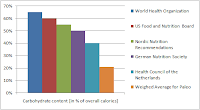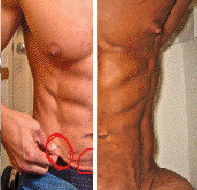 |
| Image 1: Intermittent fasting, breaking the fast, macronutrient ratios and timing, caloric zigzagging and refeeds - learn how it can be done, learn how Adelfo does it! |
But now, without further delay Adelfo Cerame's Thursdaily Suppversity post for YOU to enjoy (the rest is ad-free, I guarantee ;-)
The intermittently fasted physique (re-)engineering nutrition 101 ;-)
If I had to name one question I get most, by clients, but even more so, by people who see me train in the gym or read my blogs, here at the SuppVersity is how I am timing my carbohydrates and meals. Especially with the folks who follow an IF style protocol, questions such as ...
- “When should I eat my carbs?”
- “How should I distribute my carbs?”
- “What should my carb intake be on training days & rest days?”
- “What about caloric zigzagging”
Yeah, I know you thought "A Calorie is Not a Calorie" - that may be true, but only as long as you are referring to the black on white figures you see printed on the labels of the junk you can buy at the supermarket - intermittent fasting or not, at the end of the day, the most important determinant of whether you are or aren't progressing towards your goal is still the difference between the energy you derive from the foods you eat and the energy your body actually expends.
You may notice that I am not talking about simple "calories vs. calories out" calculations you could do based on calorie tables and the figures your stupid heart rate monitor or treadmill are displaying. I am talking about the BIG PICTURE you always have to keep in mind and which must be set straight and be geared to your goals, i.e. weight loss, muscle or strength gains, etc., before you even start thinking about whether any those "optimizations" of which I found that they work for me will work for you, as well.
My Twist to the Original Leangains Regimen
For those of you who have been following my Thursday Blogs for the past year or so, it won't be news that follow a 16/8 intermittent fasting protocol (this means 16h of fasting are followed by a 6h feeding window) - this protocol is based on the same fundamental principles as Martin Berkhan’s Leangains regimen. I don’t follow the exact protocol to a “T’’ (you know I am not changing Martin's girlfriend either ;-), but I stay along the guidelines, with added tweaks here and there to what’s suitable and work well for me… So here is what I prefer to do when I break my fast and do my meal/carb timing during my 8 hour feeding window.
- When do I eat my carbs? On training days, I prefer a protein + fat meal before I train because I feel my body runs better on dietary fats, when I train as oppose to having a big carb meal – so a protein shake + coconut oil (as a sponsored athlete I obviously use Myotropics Physique 2.0 and while I would recommend you give it at least a try, you can certainly use your favorite protein powder - preferably no whey isolate, but something "slower", like milk or a protein blend). The nourishing and long-lasting mix of WM-HDP, milk protein + MCTs from the coconut oil is more than enough for me to fuel my workouts.
When I am back home from my workout my first real meal of the day is the one, where I place the lion's share of my carbohydrate intake. So, the meals after I train are usually high in protein and moderate to high in carbohydrates, while keeping the fat intake very modest. The reason I use this strategy is to make full use of the repartitioning effect after the workout, when your muscles will suck up more glucose in the presence of relatively moderate insulin levels. Since this "post workout window" (suggested read "Opening the 'Anabolic Barn Door' With the Key of Exercise and Nutrition Science!") also happens to fall in the evening, I don't have to worry about (a) bunking later in the day or (b) overeating and feeling sluggish, I just fill myself up with carbs and relax... when I go to bed later, I am still happy and satiated and ready to get some quality sleep.
Image 3: As it turns out the "anabolic window" is more of a barnyard door, than ...read more
- Which carbohydrate sources do I use on workout days? While I am now going to give you a list, the latter is not supposed to be extensive - it's more to give you an idea of the broad range you can pick from without ever having to resort to the "carbage" that's making people fat and sick and has brought all carbs into disrepute.

Figure 1: Recommended (mean) carbohydrate intake in %-age of total calorie consumption ... read more - sweet fruits like ripe bananas, pineapples, mangoes, cherries, papayas
- starchy carbs like sweet potatoes, organic russets, yams, colored potatoes, butternut squash, rice
- variety of veggies
On non-training days I spread my macros pretty evenly across the 6h feeding window, with a lower carb intake on non-workout days and mostly being from veggies and fruits this will allow for optimal insulin levels all-day. Consequently, all my meals are high protein + high fat based; I've always fared very well with this strategy and feel that my body doesn’t need much carbohydrates on days I don’t train and those I do eat mostly come from...- a variety of veggies, which I always eat to satiety
- a couple of slices of tropical fruits such as pineapples, papayas, plantains, kiwi, mango, coconuts, guava…
- Caloric ZigzaggingCaloric zigzagging is another one of those advanced techniques I hinted at in the introductory part of this blog, it can facilitate and optimize fat loss, but is neither necessary to make progress nor optimal for everyone. Caloric zigzagging is not a must and not for everyone, either: In my opinion, caloric zigzagging, is not a beginner technique and the benefits are too small to risk getting totally confused . For beginners or people that just get confused with tracking numbers its much easier to just diet down and incorporate re-feed days rather than having to remember “x amount of carbs on this day, and x amount of carbs on that day” … But for individuals like myself… I don’t mind. Plus, with the protocol I follow, where I eat starchier carbs on training days and more fibrous carbs on non-training days; my caloric intake will tend to be lower on rest-days, anyways.Rather than just following a regular downward spiral, where you continuously decrease a constant daily calorie intake (independ of whether you work out or not) over a pre-defined, short timespan (4-6 weeks), caloric zigzagging will add an andditional "zigzag" component to the regimen, where you will now vary your calorie (and macronutrient intake according to whether you train or rest on a given day: Basically the idea is you will eat a little bit more, when you train to make use of the priming effect workouts have on the departments (muscle vs. fat) your body is going to store the nutrients, respectively the energy it derives from it in. On non-training days, on the other hand you eat less, and have your body feed of his body fat stores. There is however one thing you must never forget: At the end of the day it’s still about energy in, energy out, and your overall food consumption. Caloric zigzagging is just another one of those little pieces to the BIGGER PICTURE in which, as Dr. Andro would say it, "weight gain and weight loss are nothing but the two complementary and yet incommensurable sides of the same coin".
So, for example, my training day macros can look something like this; 200g protein/ 150g carbs/ 65g fat – then my rest day macros would look like this: 200g protein/ <100g carbs/ 65g fat. And again, different scenarios or phases in your cut will dictate how you make your macronutrient adjustments. Sometimes I can start off doing caloric zigzagging and by the tail end of my diet; I’m back to the good old proven and effective downward dieting.
- How do I incorporate refeeds into my intermittent fasting routine? Re-feed days are usually incorporated into a diet once an individual starts to get leaner, calories are decreased, and metabolism starts to level out. In my experience, I did not have to incorporate re-feeds into my diet for the first 3 months. I had a cheat day, when Thanksgiving, Christmas and New Years came around but those were the only cheat days I incorporated into my diet for the first 3 months from October – January. The rest of the days out of those 3 months, I did just fine.
I didn’t start incorporating re-feed days until around maybe mid-January, when I was really starting to dip into the single digit body fat % range. I would then still follow my 16/8 protocol and break fast on Sunday as I would any other day, but the leaner I got, the bigger and more important my Sunday refeeds became - to the point, where I was starting my re-feeds and breaking fast @ 10am and ending my them at 11pm. Lol.
During my first contest prep of this year my re-feed days were pretty ridiculous. I never kept track of what I ate on my Sunday re-feeds. The only guidelines I followed were keep protein moderate, fats low, and carbs HIGH! And I ate literally the whole day. I never kept track but one Sunday I was curious to see how much carbs I was taking in, and I must have had almost ate 800+ grams of carbs that whole Sunday! And just in case you’re curious about this type of re-feed type style, it’s called skiploading (google it, and you’ll get the concept of it)! Or you can just double back to one of my re-feed blogs from a couple months back.
During my 2nd contest prep of this year my re-feeds were a bit more controlled this time around. I learned from a couple of Dr. Andro’s articles (esp. "Carbohydrate Shortage in Paleo Land") that the average indidual would not need more than max. 400g of carbs to refill his glycogen stores (needless to say that those must not all come from dextrose or be eaten in one meal).Image 4: It's not just the nasty subcutaneous water you can avoid, when you don't abuse your refeed days to binge like a maniac!
Moreover, our glycogen stores don’t get as depleted as we think. It’s damn near impossible to fully deplete your glycogen stores during a single workout. Even after an intense session of high volume training, I don’t think even 50% of our glycogen stores get depleted – So long story short, I realized that I didn’t need to go overkill on the re-feeds 400g is more than enough to fill glycogen stores.
I stuck to this principle and it has not just always worked well for me, but also helped me to avoid the nasty bloating, the gastrointestinal distress and the all the other dreaded short term and often overlooked negative longterm health effects of stuffing yourself with carbage fooling yourself to believe you were "refuelling your glycogen stores".
I hope this helps you answer some of your questions, provide orientation and give you inspiration to design and tweak your own (intermittent fasting) diet routine. And while this is all I have for you today, SuppVersity readers you are of course welcome to post additional questions and comments in the comment area below! So, tune in next week for another session with yours truly ;-)

